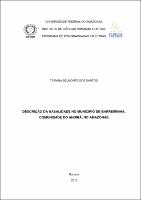| ???jsp.display-item.social.title??? |


|
Please use this identifier to cite or link to this item:
https://tede.ufam.edu.br/handle/tede/2393| ???metadata.dc.type???: | Dissertação |
| Title: | Descrição da nasalidade no município de barreirinha, comunidade do Andirá, no Amazonas |
| ???metadata.dc.creator???: | Santos, Tatiana Belmonte dos  |
| ???metadata.dc.contributor.advisor1???: | Campos, Maria Sandra |
| First advisor-co: | Stein, Cirineu Cecote |
| ???metadata.dc.description.resumo???: | A nasalidade na língua portuguesa é um tema de estudo rico em aspectos linguísticos. O objetivo desta dissertação é descrever a nasalidade na fala dos moradores nativos do Município de Barreirinha, na Comunidade de Freguesia do Andirá, localizada ao norte do município de Parintins e a leste do estado do Pará, a 331 km da capital do Amazonas, a cidade de Manaus. Através de um estudo diacrônico da nasalidade do latim até o português moderno, é possível identificar o seu surgimento e as suas transformações no decorrer da História. Alguns aspectos da nasalidade no português arcaico, em especial a variação que existia em Lisboa- -Coimbra, descrita por Bueno (1967), servem de auxílio para a compreensão do fenômeno registrado na Comunidade do Andirá. Este fenômeno trata-se da produção de som oral de vogais em ambientes fonológicos, onde, por convenções usuais da fonologia da língua portuguesa, deveriam sofrer leve nasalização, como, por exemplo, a vogal /a/ na palavra santo. Dentre os demais objetivos deste trabalho, destacam-se a quantificação do fenômeno registrado na Comunidade investigada e o levantamento de hipóteses que possam explicar a sua ocorrência. Foram utilizadas, como parâmetro para a identificação e constatação do fenômeno em questão, as descrições da nasalidade na Fonética e na Fonologia da língua portuguesa. Este é um trabalho quali-quantitativo, que segue os parâmetros da teoria sociovariacionista. A coleta de dados foi realizada em Freguesia do Andirá, através de entrevista a 18 (dezoito) informantes, sendo 06 (seis) homens e 06 (seis) mulheres, de 03 (três) grupos etários distintos, jovens, adultos e idosos, os quais eram nativos e moradores da Comunidade. O corpus contemplou 69 (sessenta e nove) palavras. Os dados foram analisados à luz da Fonética Experimental, com a utilização do Software Praat, através do qual obtivemos as ferramentas de registro experimental do fenômeno. E, ainda, seguimos a sociolinguística variacionista para analisar os dados nos âmbitos das variações gênero/sexo, idade e escolaridade. A análise dos dados coletados indicou a constatação de uma variação de nasalidade em Barreirinha, que se assemelha à variação ocorrente no português arcaico, e, ainda, apontou para um processo de transformação do fenômeno, considerando-se as variáveis sociolinguísticas analisadas |
| Abstract: | The nasality in Portuguese is a rich topic of study in linguistic aspects. The aim of this essay is to describe the nasality in the speech of native residents of Barreirinha, in the Community of Freguesia do Andirá, located north of the city of Parintins and east of the state of Pará, 331 km from the capital of Amazonas, Manaus. Through a diachronic study of nasality from Latin to the modern Portuguese, it is possible to identify its emergence and its transformations throughout history. Some aspects of nasality in archaic Portuguese, especially the variation that existed in Lisbon-Coimbra, described by Bueno (1967), works out as an aid to understanding the phenomenon that has been registered in the Community of Andirá. This phenomenon comes from the oral sound production of vowels in phonological environments, where, for the usual conventions of Portuguese phonology, should suffer slight nasalization, for example, the vowel /a/ in the word santo. Among the other objectives of this study, we highlight the quantification of the phenomenon investigated and registered in the Community, and the set up of hypotheses that may explain its occurrence. It was used as a parameter for identification and verification of the phenomenon in question, descriptions of nasality in Phonetics and Phonology of Portuguese. This is a qualitative and quantitative study, which follows the parameters of the theory social variationist theory. Data collection was performed in the Freguesia do Andirá through an interview to 18 (eighteen) informants, being 06 (six) men and 06 (six) women, from 03 (three) different age groups, young people, adults and elderly, whom were natives and residents of the Community. The corpus included 69 (sixty-nine) words. The data were analyzed lighted by the Experimental Phonetics, using the Praat software, through which we obtained experimental tools to record the phenomenon. And yet, we followed the patterns of the variationist sociolinguistics to analyze the data in terms of the variations gender/sex, age and education level. The data analysis indicated the discovery of a variation of nasality in Barreirinha, which resembles the variation occurring in the archaic Portuguese, and also pointed to an ongoing transformation of the phenomenon, considering the analyzed sociolinguistic variables |
| Keywords: | Nasalidade Sociolinguística Fonética Experimental Nasality Sociolinguistics Experimental Phonetics |
| ???metadata.dc.subject.cnpq???: | LINGUÍSTICA, LETRAS E ARTES: LETRAS |
| Language: | por |
| ???metadata.dc.publisher.country???: | BR |
| Publisher: | Universidade Federal do Amazonas |
| ???metadata.dc.publisher.initials???: | UFAM |
| ???metadata.dc.publisher.department???: | Instituto de Ciências Humanas e Letras |
| ???metadata.dc.publisher.program???: | Programa de Pós-graduação em Letras |
| Citation: | SANTOS, Tatiana Belmonte dos. Descrição da nasalidade no município de barreirinha, comunidade do Andirá, no Amazonas. 2013. 107 f. Dissertação (Mestrado em Letras) - Universidade Federal do Amazonas, Manaus, 2013. |
| ???metadata.dc.rights???: | Acesso Aberto |
| URI: | http://tede.ufam.edu.br/handle/tede/2393 |
| Issue Date: | 21-Jan-2013 |
| Appears in Collections: | Mestrado em Letras |
Files in This Item:
| File | Description | Size | Format | |
|---|---|---|---|---|
| Tatiana Belmonte dos Santos.pdf | 5.13 MB | Adobe PDF |  Download/Open Preview |
Items in DSpace are protected by copyright, with all rights reserved, unless otherwise indicated.




